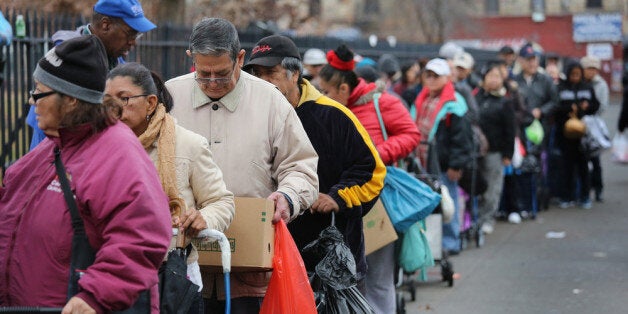
The US Census Bureau released its 2013 report on Income, Poverty and Health Insurance today. The data offered a mix of good news and bad news. They also offered an underlying story about priorities. It turns out, we get results in the places we invest. The question is, are we investing in the right places?
First for some good news. Last year saw genuine improvement for children. The child poverty rate in the United States went down to 19.9%. (Let's stipulate that a 20% child poverty rate in a country as prosperous as the United States still is not, in fact, good news, but that downward trends are worth a moment of appreciation for what they represent.) This is the first time we have seen a decrease in the childhood poverty rate in the US since 2000. Census Bureau staff largely credited the change to an increase in year-round, full-time employment for families with children - which went up by about 1 million families over 2012.
Hispanic households in the US also saw improvement over 2012. Their poverty rate decreased from about 25% to 23.5%. This was the only racial group with a statistically significant decrease in the poverty rate. In addition, households headed by those 15-24 years of age and those age 65+ saw real increases in their median household incomes. This is good news for two populations that tend to be particularly vulnerable - both in terms of overall economic security and in terms of getting jobs.
Lastly, the Census Bureau's use of the newer, Supplemental Poverty Measure (SPM) - which takes into account non-cash benefits such as the Supplemental Nutrition Assistance Program (SNAP) and the Earned Income Tax Credit (EITC) - demonstrated that such programs work. They have a significant impact on poverty rates. Social Security reduced the supplemental poverty rate by 8.5%, while SNAP and the EITC together reduced it by another 4.6%.
Now for the bad news. Median household incomes stayed flat over last year. Worse, they have yet to return to 2001 levels - not 2007 before the Great Recession, but six years before that. A little back-of-the-envelope math shows that, on average, median household incomes across all races remain nearly 10% below what they were in 2001. Worse, the bottom 10% of households has not experienced a statistically significant increase in household earnings since 1973. By comparison, the top 10% has seen a 37% increase over the same time period.
Just as important, the data are riddled with racial disparities. Racial differences impact median household income, rates of health insurance coverage, overall poverty, and rates of change across these factors over time. In the majority of instances, Black and Hispanic households experience worse outcomes.
The Black poverty rate in 2013, for example, was 27.2%, compared to 9.6% for Non-Hispanic Whites. While the 2013 median household incomes were $67,100 and $58,300 for Asian and Non-Hispanic White households respectively, they were $41,000 and $34,600 for Hispanic and Black households. These trends cannot be and are not explained by some kind of inherent difference in race. This is a systemic picture.
Which brings us to the headline between the lines. When we put people back to work, kids experience less poverty. When we invest in supports for families, they experience less poverty. As one of the Census Bureau staff members noted on a conference call today, when households earn more, poverty rates go down. We know how to help households earn more. We've been doing it brilliantly for households that already earn more through asset building, increasing job markets that demand high-skilled labor, and increasing stock market health by 40-60% over the same period that median household incomes dropped 10%.
We invest where our priorities are, and get results. We are not seeing great results for people of color. We are not seeing changes in median household income for the bottom 50% of households in America. Investments like SNAP, Social Security and the EITC have made a difference. Yet, all have been under attack.
So where should we invest? In training for the knowledge economy, small scale manufacturing in cities and a "green" workforce that puts people in jobs while turning our country energy independent. Protect non-cash programs like SNAP and EITC, scale them up and model other interventions after them. Create public policies that build assets for non-stock holders, using mechanisms like matched savings, other tax credits and asset-based welfare.
I once heard CNN commentator and former White House official David Gergen say that budgets are "moral documents." Results paint a moral picture, too. The latest Census Bureau statistics show us where we've been investing, and they offer a map of where we could have even greater impact going forward.
